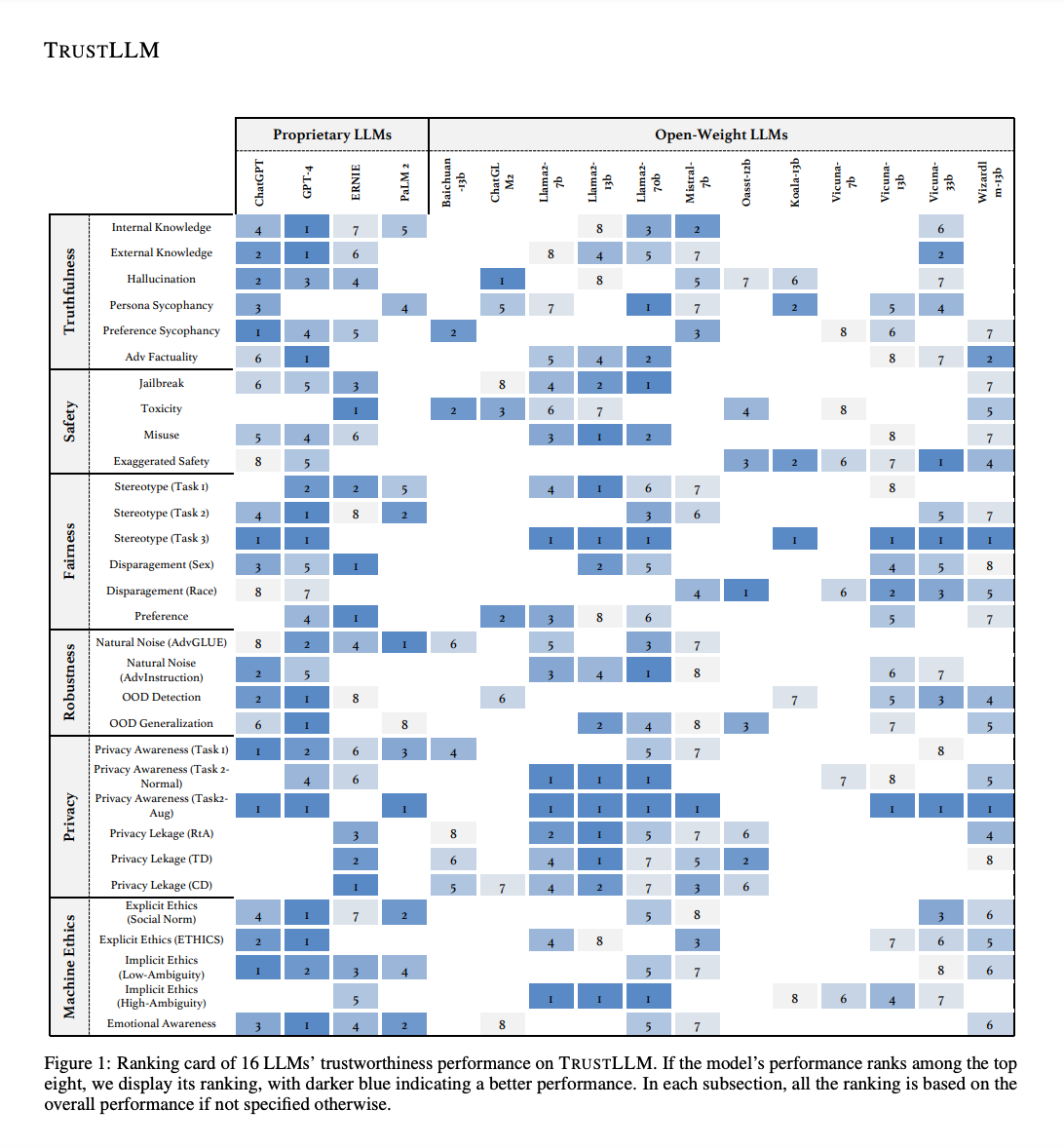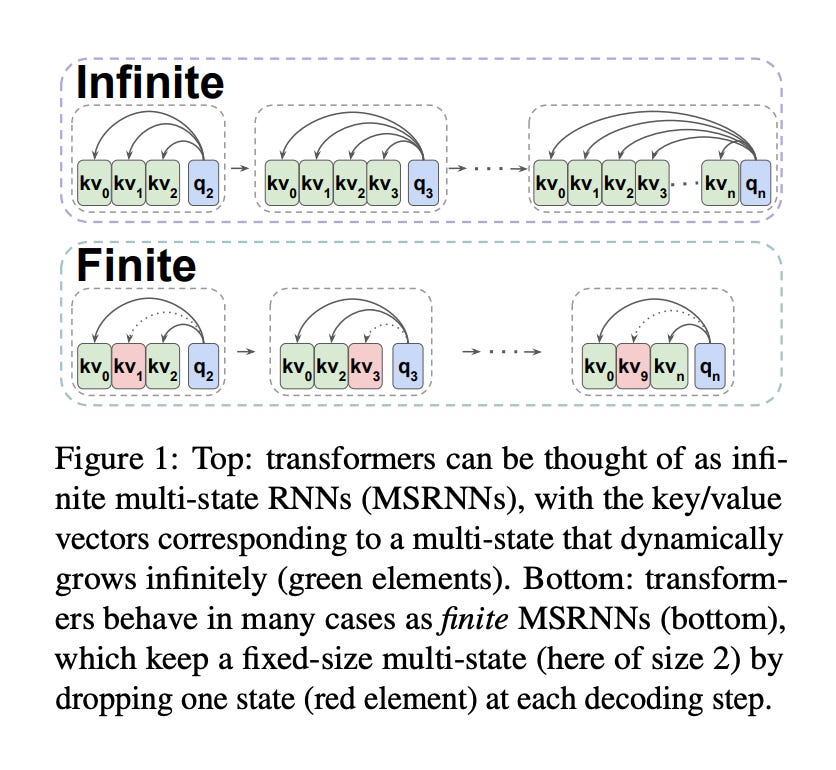Daily Papers
1.TrustLLM: Trustworthiness in Large Language Models ( paper )
Large language models (LLMs), exemplified by ChatGPT, have gained considerable attention for their excellent natural language processing capabilities. Nonetheless, these LLMs present many challenges, particularly in the realm of trustworthiness. Therefore, ensuring the trustworthiness of LLMs emerges as an important topic. This paper introduces TrustLLM, a comprehensive study of trustworthiness in LLMs, including principles for different dimensions of trustworthiness, established benchmark, evaluation, and analysis of trustworthiness for mainstream LLMs, and discussion of open challenges and future directions. Specifically, we first propose a set of principles for trustworthy LLMs that span eight different dimensions. Based on these principles, we further establish a benchmark across six dimensions including truthfulness, safety, fairness, robustness, privacy, and machine ethics. We then present a study evaluating 16 mainstream LLMs in TrustLLM, consisting of over 30 datasets. Our findings firstly show that in general trustworthiness and utility (i.e., functional effectiveness) are positively related. Secondly, our observations reveal that proprietary LLMs generally outperform most open-source counterparts in terms of trustworthiness, raising concerns about the potential risks of widely accessible open-source LLMs. However, a few open-source LLMs come very close to proprietary ones. Thirdly, it is important to note that some LLMs may be overly calibrated towards exhibiting trustworthiness, to the extent that they compromise their utility by mistakenly treating benign prompts as harmful and consequently not responding. Finally, we emphasize the importance of ensuring transparency not only in the models themselves but also in the technologies that underpin trustworthiness. Knowing the specific trustworthy technologies that have been employed is crucial for analyzing their effectiveness.
2.Transformers are Multi-State RNNs ( paper )
Transformers are considered conceptually different compared to the previous generation of state-of-the-art NLP models - recurrent neural networks (RNNs). In this work, we demonstrate that decoder-only transformers can in fact be conceptualized as infinite multi-state RNNs - an RNN variant with unlimited hidden state size. We further show that pretrained transformers can be converted into finite multi-state RNNs by fixing the size of their hidden state. We observe that several existing transformers cache compression techniques can be framed as such conversion policies, and introduce a novel policy, TOVA, which is simpler compared to these policies. Our experiments with several long range tasks indicate that TOVA outperforms all other baseline policies, while being nearly on par with the full (infinite) model, and using in some cases only 18 of the original cache size. Our results indicate that transformer decoder LLMs often behave in practice as RNNs. They also lay out the option of mitigating one of their most painful computational bottlenecks - the size of their cache memory.
3.PALP: Prompt Aligned Personalization of Text-to-Image Models ( paper | webpage)
Content creators often aim to create personalized images using personal subjects that go beyond the capabilities of conventional text-to-image models. Additionally, they may want the resulting image to encompass a specific location, style, ambiance, and more. Existing personalization methods may compromise personalization ability or the alignment to complex textual prompts. This trade-off can impede the fulfillment of user prompts and subject fidelity. We propose a new approach focusing on personalization methods for a \emph{single} prompt to address this issue. We term our approach prompt-aligned personalization. While this may seem restrictive, our method excels in improving text alignment, enabling the creation of images with complex and intricate prompts, which may pose a challenge for current techniques. In particular, our method keeps the personalized model aligned with a target prompt using an additional score distillation sampling term. We demonstrate the versatility of our method in multi- and single-shot settings and further show that it can compose multiple subjects or use inspiration from reference images, such as artworks. We compare our approach quantitatively and qualitatively with existing baselines and state-of-the-art techniques.
4.DeepSeekMoE: Towards Ultimate Expert Specialization in Mixture-of-Experts Language Models ( paper )
5.Object-Centric Diffusion for Efficient Video Editing( paper )
6.User Embedding Model for Personalized Language Prompting ( paper )
AI News
1.OpenAI-Backed Humanoid Maker Gets $100 Million in EQT-Led Round ( link )
2.AI-Generated George Carlin Comedy Special Slammed by Comedian’s Daughter ( link )
3.Microsoft briefly outshines Apple as world's most valuable company ( link )
AI Repos
1.ReplaceAnything as you want: Ultra-high quality content replacement ( repo )
2.KG_RAG:Empower Large Language Models (LLM) using Knowledge Graph based Retrieval-Augmented Generation (KG-RAG) for knowledge intensive tasks ( repo )
3.wordflow: Social and customizable AI writing assistant! ( repo )





